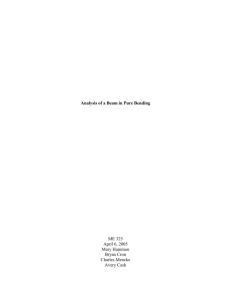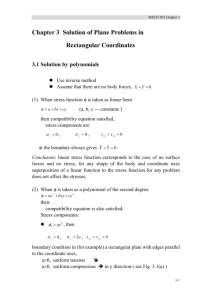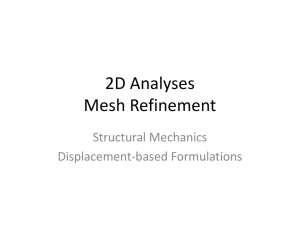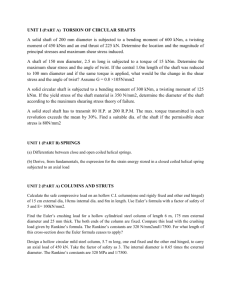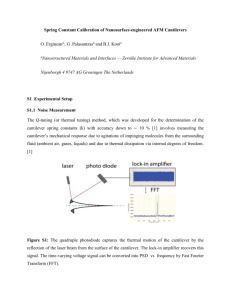MEP 2nd Ed Worked solutions Chap 09
advertisement
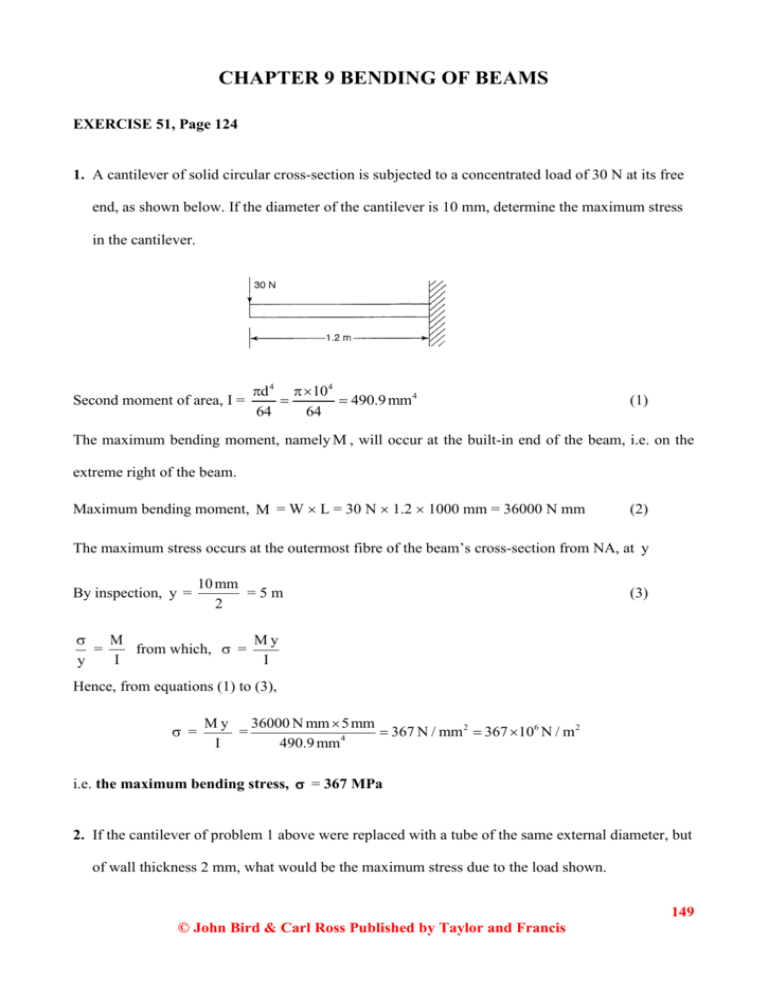
CHAPTER 9 BENDING OF BEAMS EXERCISE 51, Page 124 1. A cantilever of solid circular cross-section is subjected to a concentrated load of 30 N at its free end, as shown below. If the diameter of the cantilever is 10 mm, determine the maximum stress in the cantilever. Second moment of area, I = d 4 104 490.9 mm 4 64 64 (1) The maximum bending moment, namely M , will occur at the built-in end of the beam, i.e. on the extreme right of the beam. Maximum bending moment, M = W L = 30 N 1.2 1000 mm = 36000 N mm (2) The maximum stress occurs at the outermost fibre of the beam’s cross-section from NA, at y By inspection, y = 10 mm =5m 2 (3) M My = from which, = I I y Hence, from equations (1) to (3), = M y 36000 N mm 5 mm 367 N / mm 2 367 106 N / m 2 = 4 I 490.9 mm i.e. the maximum bending stress, = 367 MPa 2. If the cantilever of problem 1 above were replaced with a tube of the same external diameter, but of wall thickness 2 mm, what would be the maximum stress due to the load shown. 149 © John Bird & Carl Ross Published by Taylor and Francis I= D 2 4 D14 64 104 64 = 64 = 427.3 mm 4 y = 5 mm and M = 36000 N mm from Problem 1. = M y 36000 N mm 5 mm 421N / mm 2 421106 N / m 2 = I 427.3mm 4 i.e. the maximum bending stress, = 421 MPa 3. A uniform section beam, simply supported at its ends, is subjected to a centrally placed concentrated load of 5 kN. The beam’s length is 1 m and its cross-section is a solid circular one. If the maximum stress in the beam is limited to 30 MPa, determine the minimum permissible diameter of the beam’s cross-section. M = W L = 2.5 kN 0.5m = 2500 N 0.5 1000 mm = 1.25 10 6 N mm ˆ 30 MPa 30 N / mm2 y= d 2 My = = I d 1.25 106 N mm mm 2 30 N / mm 2 d 4 mm 4 64 i.e. 30 1.25 106 64 2 d 3 from which, d3 1.25 106 64 424413 2 30 Hence, d 3 424413 i.e. diameter, d = 75 mm 150 © John Bird & Carl Ross Published by Taylor and Francis 4. If the cross-section of the beam of Problem 3 were of rectangular shape, as shown below, determine its dimensions. Bending can be assumed to take place about the xx axis. From Problem 3, = 30 MPa, M = 1.25 106 N mm D D3 D 4 D bD 2 Now y = and I = 2 12 12 24 3 From above, = My I 1.25 106 i.e. 30 = i.e. D3 from which, D= and b= D4 24 D 6 2 1.25 10 12 D3 1.25 106 12 500000 30 3 500000 = 79.4 mm D 79.3 = 39.7 mm 2 2 Hence, the dimensions of the beam are 79.4 mm by 39.7 mm 5. If the cross-section of the beam of Problem 3 is a circular tube of external diameter d and internal diameter d/2, determine the value of d. 4 d d4 2 d If d is the external diameter, I = and y 64 2 From problem 3, M = 1.25 10 6 N mm 151 © John Bird & Carl Ross Published by Taylor and Francis ˆ yˆ M ˆ I d d 1.25 106 2 2 30 4 d4 15 4 d d 16 16 64 64 1.25 106 hence, 15 4 2 1.25 106 d 64 16 d 30 Hence, i.e. 0.0920d3 41666.67 and d3 Hence, 41666.67 = 452898.6 0.0920 external diameter, d = 3 452898.6 = 76.8 mm 6. A cantilever of length 2 m, carries a uniformly distributed load of 30 MN/m, as shown below. Determine the maximum stress in the cantilever. l wl2 30N / m 22 m 2 60 N m 60 103 N mm M = w l 2 2 2 d = 25 mm; ŷ ˆ d 25 = 12.5 mm; 2 2 I= d 4 254 19175 mm 4 64 64 ˆ yˆ 60 103 N mm 12.5 mm M I 19175 mm 4 i.e. maximum stress = 39.1 MPa 7. If the cantilever of Problem 6 were replaced by a uniform section beam, simply supported at its ends and carrying the same uniformly distributed load, determine the maximum stress in the beam. The cross-section of the beam may be assumed to be the same as that of Problem 6. 152 © John Bird & Carl Ross Published by Taylor and Francis M̂ = 30 N × 1 m – 30 N × 1 m × 0.5 = 15 N m = 15 103 N mm Using the values from Problem 6 gives: ˆ M̂ y 15 103 N mm 12.5 mm I 19175 mm 4 i.e. maximum stress = 9.78 MPa 8. If the load in Problem 7 were replaced by a single concentrated load of 120 N, placed at a distance of 0.75 m from the left support, what would be the maximum stress in the beam due to this concentrated load. Taking moments about B gives: R1 2 120 2 0.75 i.e. R1 = 150 = 75 N 2 M̂ occurs at point C, and M̂ = R 1 × 0.75 = 75 × 0.75 = 56.25 N m = 56.25 103 N mm ˆ M̂ y 56.25 103 N mm 12.5 mm I 19175 mm 4 i.e. maximum stress = 36.7 MPa 153 © John Bird & Carl Ross Published by Taylor and Francis 9. If the beam shown in problem 6 were replaced by another beam of the same length, but which had a cross-section of tee form, as shown below, determine the maximum stress in the beam. Section a 1 2 75 175 250 y y 37.5 17.5 ay 2812.5 3062.5 5875 ay2 105469 53594 159063 i 156.3 17865 18021 ay 5875 = 23.5 mm a 250 IXX ay2 i = 159063 + 18021 = 177084 mm 4 I NA IXX y2 a = 177084 – 23.5 2 × 250 = I = 39022 mm 4 ˆ M̂ y 56.25 103 N mm 23.5 mm I 39022 mm 4 i.e. maximum stress = 33.9 MPa 154 © John Bird & Carl Ross Published by Taylor and Francis EXERCISE 52, Page 125 Answers found from within the text of the chapter, pages 120 to 125. EXERCISE 53, Page 125 1. (b) 2. (b) 3. (c) 155 © John Bird & Carl Ross Published by Taylor and Francis



